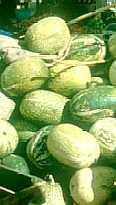View crop
View crop Data sheet EcoPortCucurbita ficifolia
 |
|
| Notes |
|---|
| BRIEF DESCRIPTION A herbaceous vine but becomming somewhat woody with a stem with numerous prickly or spiny runners becomming up to 10 m long. The fruit is globular to cylindrical 15-50 cm long, white to green with white stripes. USES Parts of the fruit are very nutritious and tender immature fruits are eaten as squash or cucumber. The flesh of the mature fruit can be candied or fermented and made into an alcoholic beverage. The seeds can be roasted and eaten as a snack, they yield an oil and is a source of protein. Young leaves and vine tips can be used as green vegetables. The male flowers and buds are used in soups, stews and salads. The plant can also be grown as an ornamental or be used as a rootstock. GROWING PERIOD Short-lived perennial, harvest may be taken after 40-120 days. COMMON NAMES Fig-leaved gourd, Malabar gourd, Black-seeded gourd, Courge de Siam, Melon Malabar, Lacayote, Silacoyote, Chili cayote, Vitoria. FURTHER INF Scientific synonym: C. melanosperma, Pepo ficifolia. Fin-leaved gourd probaably originated in Mexico. It can be found in the Andean mountains at elevations from 1000 to 2800 m. A yield of up to 50 t/ha of mature fruit can be realized under optrimal conditions. Can be stored (kept dry, but without any other special care) for two years. | Sources |
| SOURCES (C. ficifolia Bouche) Tindall H 1983 pp 161-162 [USE] Roecklein J 1987 pp 343 [USE, DRA, TEXT] Duke J 1975 pp 13 [PH, RAIN, TEMP] Vietmeyer N 1989 pp 206 [KTMP, TEMP, PHO, USE] Siemonsma J 1993 pp 165-167 [USE, PHO, PH, FER, DRA, TEMP] |